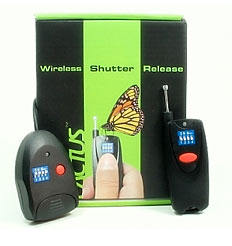It’s about freakin’ time. For years I’ve pestered family members, friends, and occasionally even strangers to stand in while I’m testing a lighting setup or indluging some photographic whim that requires a human subject in front of the lens.
Thus I’ve gradually trained all the people nearest me to duck out the back door if they see me coming with a camera in hand. “Sorry, dude, gotta run. I think my parking meter is about to expire.”
So what’s a photographer to do? I have a constant need to test lighting setups, particularly those involving multiple radio-triggered flashes, which require delicate adjustment to get the right balance. I like to know how these things are going to look before I try it out in the field. When it comes time for the actual shoot, I don’t want to force the talent, or the client, to sit through this agonizing process of tweaking.
Of course, I could put myself in front of the lens, and I tried that using the camera’s self-timer. No go, of course. When you push the shutter button, the focus locks in on the background, and when you run around in front of the camera you end up looking like a blurry blob.
I considered a cable release, but sometimes I need to be really far away from the camera for these tests, and those cables are only a couple of feet long. Fine for triggering the shutter on a tripod when you don’t want to shake the camera, but no good if you’re standing 25 feet away.
I don’t know why it took me so long to discover the wireless shutter release. I guess I thought they would be expensive, but I found one made in Hong Kong that cost me all of $30.
This thing is great. Best $30 I ever spent (well except for that time….) The tiny little transmitter is about as big as my thumb and hides easily in my hand. When you push the button halfway, it sets the focus and exposure, just as if you were pushing the camera’s shutter button halfway. Then snap. It works perfectly every time.
Now I can be my own flash test dummy. I can experiment with portrait lighting setups to my heart’s content without pissing anyone off (except myself).
The self-portrait above was shot in my living room. I would describe the technical setup for you, but that would spoil all the surprises you can find in my course “How to Shoot Professional Looking Headshots and Portraits on a Budget with Small Flashes.”
—Phil
Epilogue (added the next day): After taking all these self-portraits and posting this blog entry I had a weird dream last night. In the dream, I was holding my camera, looking through the viewfinder, and taking photos of a subject sitting on my sofa. I gradually began to realize that the subject was me. At first this seemed normal, since I had spent the afternoon taking self-portraits. But then I began to wonder—if that is me over there, then who the hell am I behind the camera? This led to an exhilarating and somewhat terrifying feeling of metaphysical confusion. So, consider yourself warned. The producers of this blog and of the Cactus Wireless Shutter Release disclaim all responsibility should your exercise in self-portraiture give rise to a philosophical conundrum or feelings of existential despair.





I can’t believe you shot that YOURSELF … in your LIVING ROOM! That’s amazing. I need to look into getting one of those little gadgets. I wonder how many flashes you used. … Can’t wait to see your flash tutorial program. I’ve been wanting to be able to do shots like that for a long time.
I bought the same triggers for the same reason, agree that it’s a huge help. Makes me wonder if I should have saved some money by buying their remote flash triggers instead of the set of PW’s that I mortgaged the house to get.
I used to feel sorry for myself because my friends and family have grown weary of having a camera pointed in their faces 24 x 7. Posing for myself is often the only option.
But I have come to realize how important it is to sit in the pose myself, see if it’s comfortable, see how the lights will see me, how the camera will see me. I think in the end it’s made me a better photographer.
Or maybe I would have gotten better faster with more willing models?
Hello Phil,
The wireless shutter release sounds interesting, but the question I have is; how do you frame yourself? This seems to be a hit and miss situation. Is there a method to this kind of madness?
May the day find you well,
Mike
Mike, it can be hit-or-miss trying to frame yourself, but once you get the position figured out you can just repeat it. Also, sometimes you can see your own reflection in the lens and use that to position yourself. The trickiest part is getting the focus point right if you are using shallow depth-of-field. It’s all too easy to get your nose in focus but your eyes out of focus, etc. There is definitely some trial and error in the process!
I’m new to all of this so perhaps this is a really dumb question. . .I use a canon 7d and 5d and have cameras set on back button focus. So to use this gadget, must I set my cameras back to focusing using the shutter buttons?
Carol, I’m not sure, try it and let us know!
Phil:
I shoot with a Canon 7D. When I went to the website to view the wireless shutter release pictured, it did not show any model for a canon. I know you have indicated you soot with a canon so I’m curious if you were using the Nikon model trigger or if there actually is one for the Canon. Thanks in advance for any info you might provide.
Sandra, that’s strange, I don’t see their Canon model listed any more either. All I can suggest is searching elsewhere for a Canon trigger. You’ll need one specific to your camera.
Where were you 65 years ago when I bought an Argus C3 and started taking pictures. I am just now learning from you how to take photographs and not just pictures. Thanks for showing me what all the dials and buttons are for and how to use them.